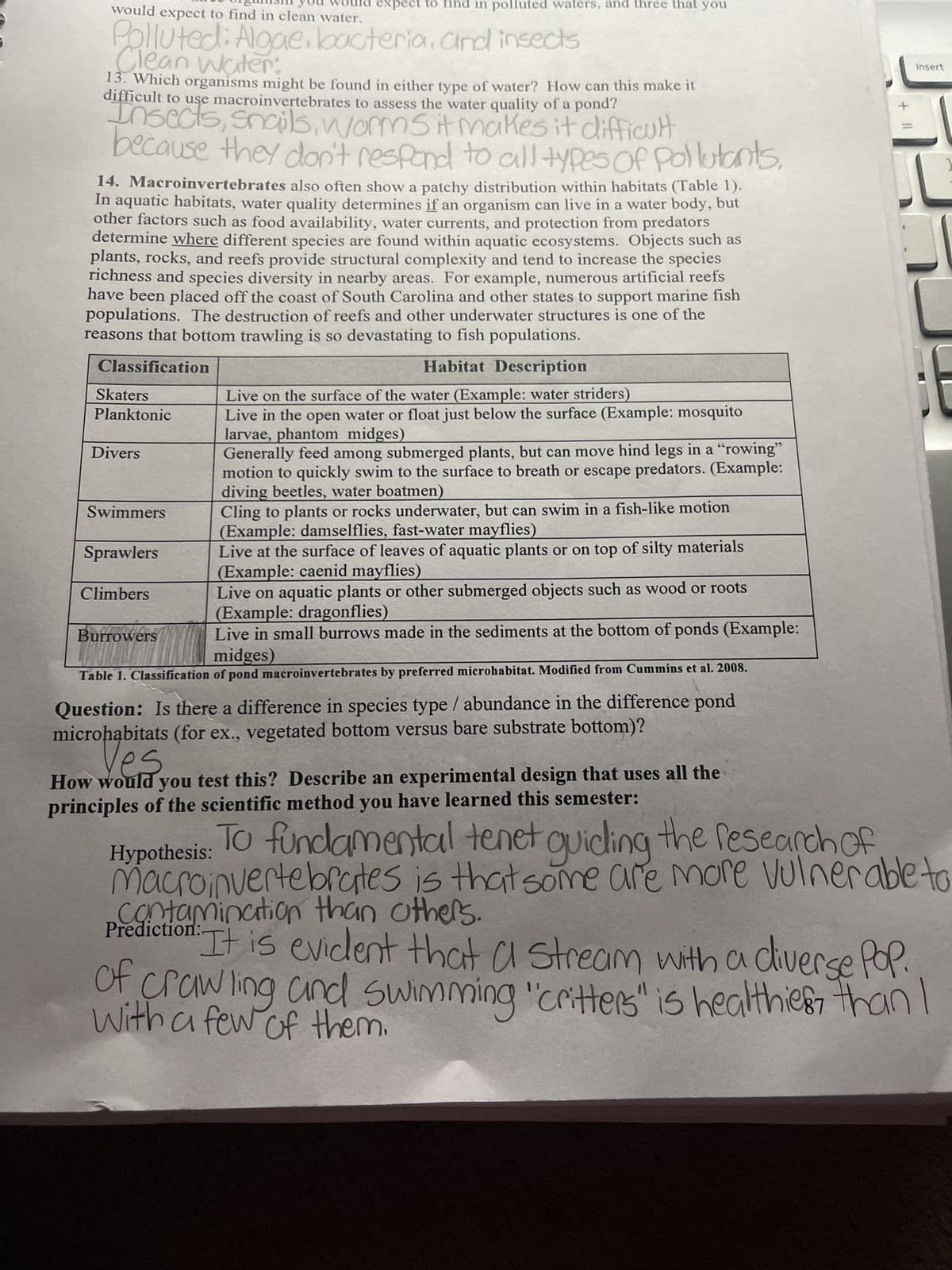Chapter1: Aquaculture Basics And History
Section: Chapter Questions
Problem 1KA
Related questions
Question
Based on this information please state the
IV=
DV=
Controlled=
control group =
experimental design=
treatment group=

Transcribed Image Text:expect to
would expect to find in clean water.
Polluted: Algae, bacteria, and insects
Clean Water:
13. Which organisms might be found in either type of water? How can this make it
difficult to use macroinvertebrates to assess the water quality of a pond?
Insects, snails, worms it makes it difficult
because they don't respond to all types of pollutants.
14. Macroinvertebrates also often show a patchy distribution within habitats (Table 1).
In aquatic habitats, water quality determines if an organism can live in a water body, but
other factors such as food availability, water currents, and protection from predators
determine where different species are found within aquatic ecosystems. Objects such as
plants, rocks, and reefs provide structural complexity and tend to increase the species
richness and species diversity in nearby areas. For example, numerous artificial reefs
have been placed off the coast of South Carolina and other states to support marine fish
populations. The destruction of reefs and other underwater structures is one of the
reasons that bottom trawling is so devastating to fish populations.
Classification
Habitat Description
Live on the surface of the water (Example: water striders)
Live in the open water or float just below the surface (Example: mosquito
larvae, phantom midges)
Skaters
Planktonic
Divers
Swimmers
in polluted waters, and three that you
Sprawlers
Climbers
Burrowers
Generally feed among submerged plants, but can move hind legs in a "rowing"
motion to quickly swim to the surface to breath or escape predators. (Example:
diving beetles, water boatmen)
Cling to plants or rocks underwater, but can swim in a fish-like motion
(Example: damselflies, fast-water mayflies)
Live at the surface of leaves of aquatic plants or on top of silty materials
(Example: caenid mayflies)
Live on aquatic plants or other submerged objects such as wood or roots
(Example: dragonflies)
Live in small burrows made in the sediments at the bottom of ponds (Example:
mac midges)
Table 1. Classification of pond macroinvertebrates by preferred microhabitat. Modified from Cummins et al. 2008.
Question: Is there a difference in species type / abundance in the difference pond
microhabitats (for ex., vegetated bottom versus bare substrate bottom)?
Ves
How would you test this? Describe an experimental design that uses all the
principles of the scientific method you have learned this semester:
Hypothesis:
+ 11
Insert
To fundamental tenet guiding the research of
Macroinvertebrates is that some are more vulnerable to
contamination than others.
diction. It is evident that a stream with a diverse Pop.
of crawling and swimming "critters" is healthies than I
With a few of them.
Expert Solution
This question has been solved!
Explore an expertly crafted, step-by-step solution for a thorough understanding of key concepts.
Step by step
Solved in 2 steps

Knowledge Booster
Learn more about
Need a deep-dive on the concept behind this application? Look no further. Learn more about this topic, biology and related others by exploring similar questions and additional content below.Recommended textbooks for you


Biology: The Unity and Diversity of Life (MindTap…
Biology
ISBN:
9781337408332
Author:
Cecie Starr, Ralph Taggart, Christine Evers, Lisa Starr
Publisher:
Cengage Learning

Biology: The Unity and Diversity of Life (MindTap…
Biology
ISBN:
9781305073951
Author:
Cecie Starr, Ralph Taggart, Christine Evers, Lisa Starr
Publisher:
Cengage Learning


Biology: The Unity and Diversity of Life (MindTap…
Biology
ISBN:
9781337408332
Author:
Cecie Starr, Ralph Taggart, Christine Evers, Lisa Starr
Publisher:
Cengage Learning

Biology: The Unity and Diversity of Life (MindTap…
Biology
ISBN:
9781305073951
Author:
Cecie Starr, Ralph Taggart, Christine Evers, Lisa Starr
Publisher:
Cengage Learning

Biology Today and Tomorrow without Physiology (Mi…
Biology
ISBN:
9781305117396
Author:
Cecie Starr, Christine Evers, Lisa Starr
Publisher:
Cengage Learning